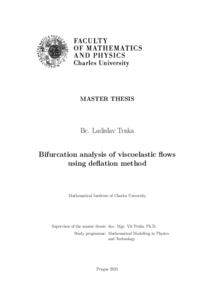Bifurcation analysis of viscoelastic flows using deflation method
Použití deflační metody ke konstrukci bifurkačních diagramů pro proudění viskoleastických tekutin
diploma thesis (DEFENDED)

View/
Permanent link
http://hdl.handle.net/20.500.11956/199965Identifiers
Study Information System: 257303
Collections
- Kvalifikační práce [11466]
Author
Advisor
Consultant
Tůma, Karel
Referee
Farrell, Patrick
Faculty / Institute
Faculty of Mathematics and Physics
Discipline
Matematické modelování ve fyzice a technice
Department
Mathematical Institute of Charles University
Date of defense
12. 6. 2025
Publisher
Univerzita Karlova, Matematicko-fyzikální fakultaLanguage
English
Grade
Excellent
Keywords (Czech)
Numerická bifurkační analýza|metoda deflated continuation|viskoelastické proudění tekutin|metoda konečných prvků|bifurkace narušující symetriiKeywords (English)
Numerical bifurcation analysis|deflated continuation method|viscoelastic fluid flows|finite element method|symmetry-breaking bifurcationsTato práce se zabývá numerickou analýzou bifurkací viskoelastických tekutin pomocí metody deflated continuation. Nejprve se zabýváme numerickými obtížemi (detekce fa- lešných stacionárních řešení) spojenými s přímočarou diskretizací rovnic pomocí metody konečných prvků a navrhneme, jak je překonat pomocí logaritmické reformulace se sta- bilizací DEVSS-TG/SUPG. Následně studujeme symetrii porušující bifurkace dvou typů viskoelastických tekutin (FENE-CR a Giesekus modely) ve dvou rovinných problémech (geometrie příčné štěrbiny a náhlé expanze). Zatímco problém příčného proudění slouží jako benchmark pro potvrzení použitelnosti přístupu deflated continuation, u problému expanzního proudění jsme pozorovali, že elasticita v tekutině může způsobit vznik bifur- kací i při menších Reynoldsových číslech. Konkrétně s postupným zvyšováním Reynold- sova čísla dochází k bifurkacím nejprve v proudění Giesekovy kapaliny, poté v proudění Newtonovské kapaliny a nakonec v proudění kapaliny FENE-CR.
This work concerns numerical bifurcation analysis of viscoelastic fluids using the de- flated continuation method. First, we address numerical difficulties (detection of spuri- ous steady-state solutions) associated with a straightforward discretisation of the equa- tions using the finite element method, and we propose how to overcome them using the logarithm reformulation with the DEVSS-TG/SUPG stabilisation. After that, we study symmetry-breaking bifurcations of two types of viscoelastic fluids (FENE-CR and Giesekus models) in two planar problems (cross-slot and sudden expansion geometries). While the cross-slot flow problem serves as a benchmark to confirm the viability of the de- flated continuation approach, for the sudden expansion flow problem, we have observed that the elasticity in a fluid can also cause the onset of bifurcations at smaller Reynolds numbers. Specifically, as the Reynolds number gradually increases, bifurcations occur first in the Giesekus fluid flows, then in the Newtonian fluid flows, and lastly in the FENE-CR fluid flows.
